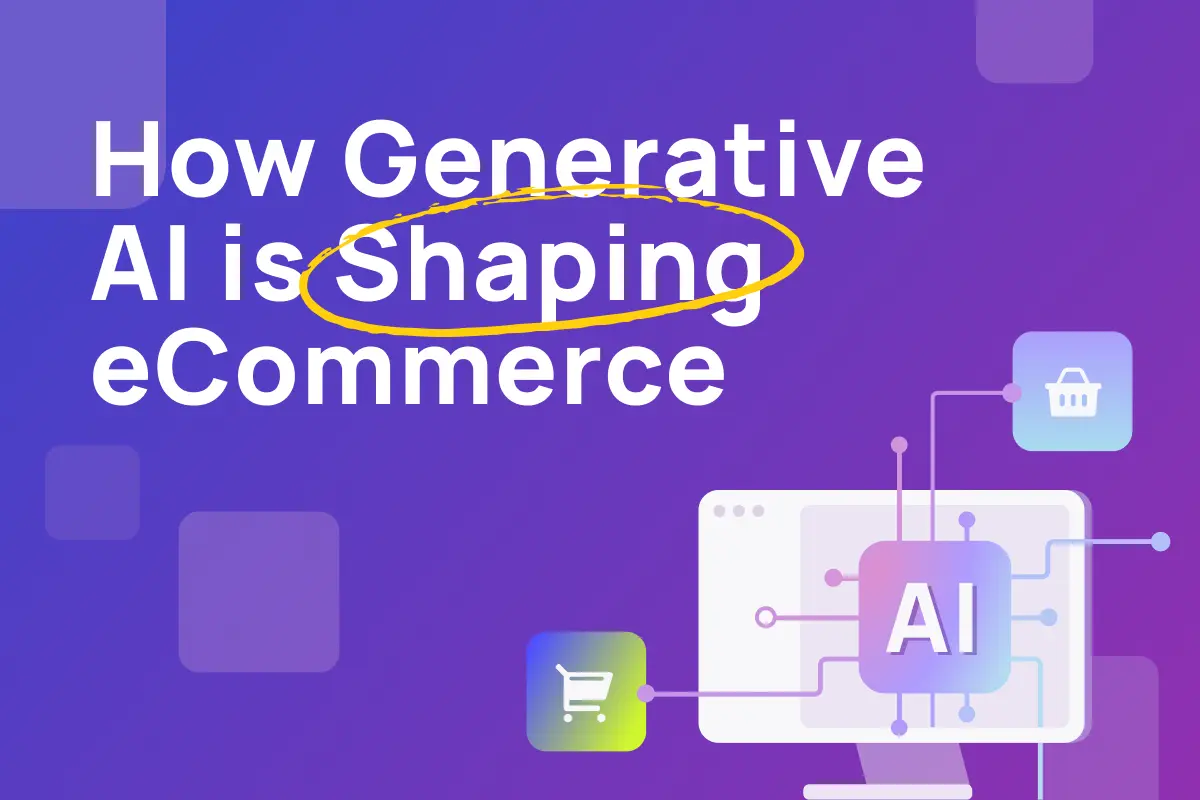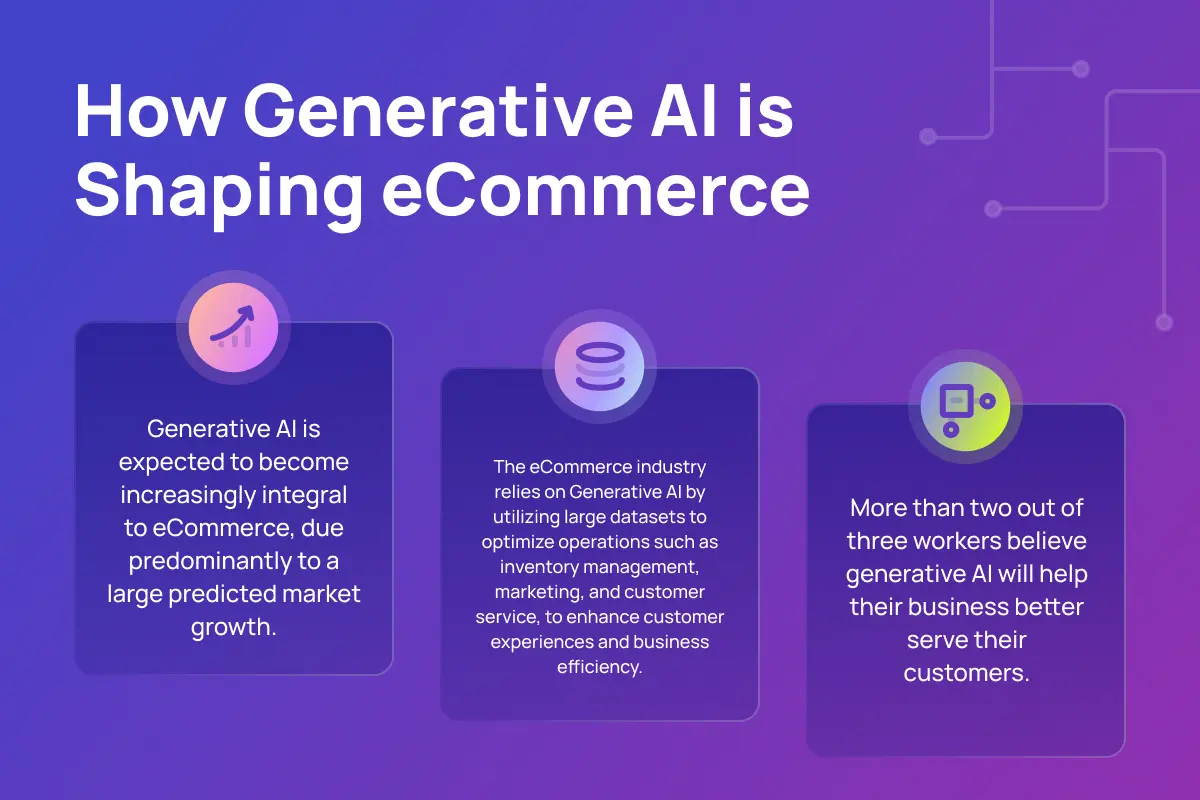
How Generative AI is Shaping E-commerce



The release of ChatGPT in 2022 took the world by storm. Since then, there seems to be a never-ending stream of new generative AI tools and software from chatbots to video generators.
But Generative AI didn’t come out of thin air.
The first generative AI tools were created as early as the 1960s. Later, in 2014, the first GANs (generative adversarial networks) arrived, allowing AI to “create” text, video, and more. Today, generative AI utilizes existing data to create new content like content, images, music, and videos.
With the generative AI market set to reach $356.10 Billion by 2030, much of this development is being driven by e-commerce, an industry quickly seeing the potential of AI technologies and using them to boost performance.

Essentially a complex and vast data processing network, generative AI models and tools are perfect for e-commerce, where knowing all the data on your business and customers is key.
Here are the basics of generative AI to help you understand how it can boost e-commerce business:
Attempting to replicate the intelligence and creativity of the human mind, generative AI comprises vast digital neural networks - a computational model inspired by the human brain.
While “AI” can refer to lots of different types of AI technology, generative AI is specifically AI that generates content - whether that’s video, audio, or text. Similarly, OpenAI is a broad company that creates lots of AI models, not just generative AI.
Within these neural networks lies the key to AI’s success: deep learning. This enables generative AI to be “trained” on vast datasets through supervised learning, helping the model learn to identify patterns and relationships within the data.
While there are many other technical elements to how generative AI models work, the crucial thing to understand is the importance of using large data sets, and the ability of these models to process and find patterns within this data.
If you want to grow your e-commerce business, you need two essential things: data on your business and a way to process the data to find what’s useful.
This is how generative AI is revolutionizing the e-commerce market.
Multiple areas of your business likely already rely on large data sets to help make decisions. Marketers have long used A/B testing to collect data and help decide what design or headline sells best - and now, according to Forbes, 55% of marketers are already using generative AI to help them.
When deciding what resources to invest in, which products to produce more of, and when and where to buy supplies, good product information management is crucial.
Within the broad umbrella of “generative AI,” there are lots of different tools at play, used by products such as ChatGPT or Midjourney. Here are just a few, along with how each tool or system can be easily integrated into e-commerce businesses to provide new insights or increase efficiency:
Neural networks are computing systems inspired by the human brain's structure, these systems can be used to analyze customer behavior. This helps businesses suggest products tailored to individual preferences, and can also create lifelike product images from product descriptions via text-to-image AI tools.
By helping algorithms learn from data, deep learning technology can be used to analyze customer reviews. This can help e-commerce businesses quickly see overall trends in their reviews, allowing them to promptly address issues or reinforce strengths.
Vital for ensuring generative AI is continuously improving, GANs can help AI art generators create realistic product images.
Specialized in processing sequences of data, RNNs are critical in automatically personalizing product recommendations based on user interactions and preferences. They can also power chatbots to engage with customers in real-time.
Despite the complex name, VAEs are used to represent complex and large data sets simply and compactly. Bringing this to e-commerce, VAEs can help automate tasks like generating product descriptions and enable the creation of novel product designs, leading to more efficient content creation and enhanced product customization options for customers.
More than two out of three workers believe generative AI will help their business better serve their customers. After all, improving the customer experience is one of the primary aims of any business, in e-commerce or otherwise.
This is where generative AI tools excel.
For several years, e-commerce businesses have been fine-tuning the best ways to offer personalized shopping experiences, from tailored ads and customer-specific product recommendations to unique emails and optimized product descriptions.
Whether it’s AI-driven product recommendations tailored to individual preferences to automatic A/B testing, generative AI is already transforming the way e-commerce increases customer satisfaction and loyalty.
And that’s not all.
AI-powered visual customization tools can enable customers to personalize products and visualize them before making a purchase, creating a sense of ownership and engagement.
Want customers to see how their custom text looks on a mug or a T-shirt? There's no need to wait until you’ve created it; AI can show a visualization before they buy and give them confidence to complete the purchase.
Generative AI can also help create realistic product images and descriptions based only on text input, making it easy for you to quickly boost the visual appeal of your e-commerce store.
Automation saves time, and whether it helps internally with Enterprise Resource Planning or content creation processes for external viewing, e-commerce businesses can apply AI across the business.
While there are many ways you can use generative AI to improve your e-commerce business, here are a few of the best ways:
Using vast data sets and immense data processing abilities, generative AI algorithms can analyze historical sales data, market trends, and external factors to give you increasingly accurate estimates of future demand.
An online clothing retailer, for example, could use AI to forecast demand for seasonal items based on historical sales patterns and current fashion trends.
This reduces waste and helps you prepare for the future, whether it's seasonal trends or specific events such as the Chinese New Year or Black Friday.
With personalization in place and customer behavior predicted through AI, you can take your automation a step further.
Automated AI content creation tools can quickly create content and advertisements using data on previous customer decisions.
For instance, an online beauty retailer could use AI-generated visuals and persuasive copy to create targeted ads for specific customer segments, resulting in higher click-through rates and conversions.
Of course, it’s important for a human eye to always check the final work carefully, whether an image or a paragraph from AI writing tools. Still, generative AI can help you reduce hours of grunt work to just the fine-tuning of your marketing strategy.
By using AI-powered chatbots, e-commerce businesses can provide 24/7 instant responses to inquiries, helping streamline customer service and resolve issues automatically, while filtering customers who need human assistance to the help they need.
With the AI industry set to grow by 37% each year from 2023 to 2030, more accurate, more efficient, and more cost-effective tools are likely to be developed.
With this, its potential to revolutionize e-commerce is boundless.
As AI models process more and more data with even higher accuracy, the strategic integration of AI into e-commerce workflows will become even more critical, with businesses using AI to more precisely predict customer choices and market trends.
Able to integrate into so many different areas of digital commerce, generative AI holds great promise for transforming the entire e-commerce space.
With careful consideration and the right tools, you can make sure your business is making the most out of one of the world’s greatest technological leaps, helping you reach customers and manage your business like never before.
By choosing proven platforms such as Trustana, you can remain confident in growing your e-commerce business ethically and with a customer-centric approach, using AI to improve your customers’ experience.
Book a demo with us today and we can show you how we will help you transform and grow your business!
Generative AI refers to technologies that create new content, such as text, images, and videos, based on learned patterns. In e-commerce, it is used to automate product content generation, personalized customer interactions, and inventory management, making operations more efficient and improving customer experiences.
Generative AI can create high-quality product descriptions, titles, and even marketing copy at scale, helping retailers avoid the time-consuming manual processes. It ensures consistent, SEO-optimized content that enhances product visibility across various digital platforms, improving conversion rates.
Generative AI enables retailers to automate the creation and adaptation of product content for multiple channels (website, marketplaces, and social media). This reduces the risk of inconsistencies and speeds up the process of getting products listed across platforms like Amazon, Shopify, and Google Shopping. The result is a unified and optimized customer experience.
AI can predict demand trends, helping retailers manage stock levels more effectively. By analyzing historical data and consumer behavior, it assists in making data-driven decisions on when to restock or discontinue products, ensuring optimal inventory turnover and reduced overhead costs.
Yes, AI can generate personalized product recommendations and targeted marketing messages. By analyzing customer data, it allows retailers to craft individualized shopping experiences, improving engagement and boosting conversions by showcasing the most relevant products to each shopper.
When integrated with tools like PIM (Product Information Management) systems and ERP (Enterprise Resource Planning) solutions, Generative AI can enhance the automation of workflows, from content creation to order fulfillment. This leads to improved operational efficiency, faster time-to-market, and better customer satisfaction.
AI can automatically enhance product images by adjusting lighting, background removal, and even generating 3D product visualizations. These enhancements create visually appealing content that improves the product’s presentation on websites and marketplaces, leading to better customer experiences and higher conversion rates.
By automating repetitive tasks like content creation, data analysis, and customer interactions, Generative AI can reduce labor costs, increase productivity, and eliminate errors. Retailers can reinvest savings into other areas of their business, driving growth and improving margins.
Generative AI optimizes product content for search engines by creating SEO-friendly descriptions, titles, and keywords. It also helps retailers stay on top of shifting trends and changing algorithms, ensuring their products rank higher in search results, both on search engines like Google and within marketplaces.
The ROI of Generative AI can be tracked through key performance indicators such as increased conversion rates, reduced time-to-market, and cost savings from automating content and customer service. Retailers can also measure customer satisfaction and engagement to determine the effectiveness of AI-driven personalization.
Some challenges include the initial setup costs, integration with existing systems, and the need for high-quality data to train the AI models. Retailers also need to ensure that AI-generated content aligns with their brand voice and values, which may require ongoing monitoring and refinement.
While Generative AI will automate many tasks, such as content creation and customer service, it is unlikely to replace human workers entirely. Instead, AI is intended to augment human capabilities, allowing employees to focus on higher-level tasks like strategy, innovation, and customer relationships.